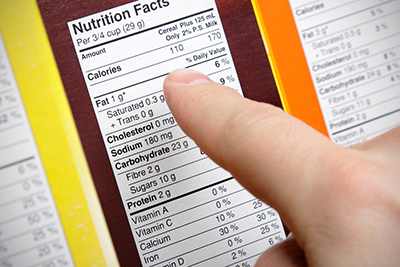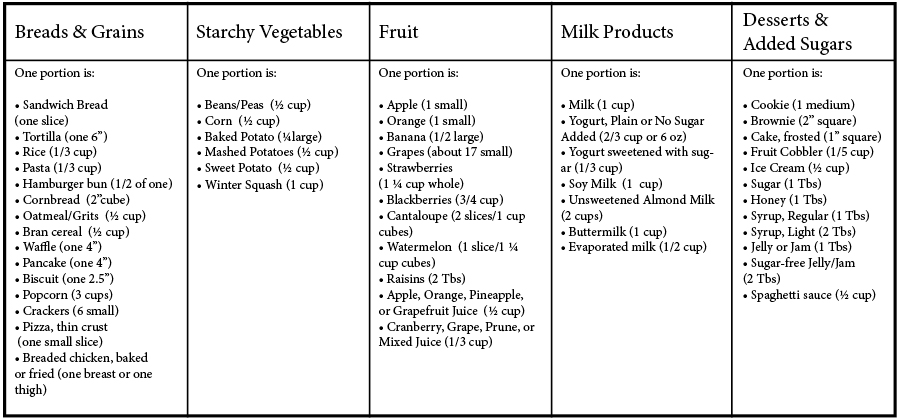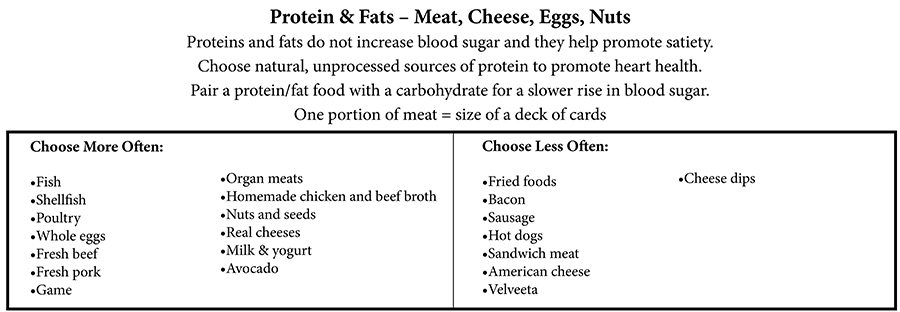The place to start when learning to eat with diabetes is knowing the three major nutrient groups and how they affect your health. The only three nutrients that provide calories are carbohydrates, proteins, and fats. Some foods have just one type while others may be a combination of all three.
Carbohydrates
Carbohydrates are the place to start when learning to eat with diabetes. They are important because they are the only class of foods that change to sugar in your body and increase your blood sugar. It is good to eat nutritious carbohydrate foods, but each person living with diabetes is unique and can tolerate a limited amount of carbohydrate at any one time without causing elevated blood sugar levels. Each person should eat as small an amount of carbohydrate at meals and snacks as is needed to control blood sugar and maintain energy levels. 
Carbohydrates are measured in grams, and one diabetic serving is 15 grams. This amount is not the same as the serving size on food labels. Each person with diabetes is unique in their ability to process the amount of carbohydrate they eat at any one sitting. One person may be able to eat four servings (60 grams) of carbohydrate at breakfast without their blood sugar becoming too elevated, while another person may only be able to handle two servings (30 grams). In order to learn how much carbohydrate your body can typically handle for each meal, test your blood sugar before and after meals for a few days. You may find that you can tolerate more carbohydrate at some meals than at others. Choose fewer servings of carbohydrate when your blood sugar is high before a meal. Aim for an increase of no more than 50 points from before you start eating until 1-2 hours after you’re done.
It is helpful to be fairly consistent with the amount of carbohydrate you eat at each meal to help your medications to work properly. If taking insulin, it is important not to skip meals and to eat enough carbohydrate to keep your blood sugar from becoming too low without eating so much that it gets too high. The key is in eating just the right amount without going over, which can be figured out with time and practice. Your prescribed medications may need adjustment as you make improvements in your diet and eat less carbohydrate, so consult with your pharmacist and your doctor for any needed changes.
Take learning to eat with diabetes step-by-step. After mastering one step, then move to the next.
1. Start by simply learning which foods are carbohydrate foods.
2. Then learn the diabetic serving size (the amount containing 15 grams of carbohydrate) for foods you typically eat from each carbohydrate category.
3. Next determine how many total servings of carbohydrate your body can handle at each meal, which for some people may be one or two servings and others may be up to five servings per meal.
4. Then, at each meal, choose any combination of carbohydrate foods that you’d like in the amount of servings your body can handle. You can choose multiple servings of the same food or mix and match as desired. Just add up the servings for each meal to reach your desired total for that meal.
Carbohydrate Food Categories & Portion Sizes Guide

The above foods are just typical examples from each category. In learning serving sizes, it can be helpful to remember that if you learn the portion size for one food, similar foods will be approximately the same size portion. For example, if you remember that one slice of bread is a serving, then it is easy to remember that the serving for a pancake or a waffle is about the same size and thickness as a piece of bread.
Remember that “sugar-free” and “no sugar added” foods still usually contain carbohydrate, so remember to check the label.
Reading Labels
Use the nutrition facts label to determine how many servings of carbohydrate are in packaged foods. Use “Total Carbohydrate” to determine how many 15 gram servings of carbohydrate are found in the food. Remember the serving size listed on the label is not the same as a diabetic serving size which is 15 grams of carbohydrate. “Dietary Fiber” and “Sugars” are included in the amount for “Total Carbohydrate.” Use these as clues to determine how healthy a particular product is and how fast it will likely cause your blood sugar to rise. A product with a high proportion of the “Total Carbohydrate” as “Sugars” will increase blood sugar more quickly and is probably a less healthy product. Products with a high proportion of “Dietary Fiber” as part of the “Total Carbohydrate” amount will increase blood sugar more slowly and is likely a healthier choice.
Non-starchy Vegetables
Non-starchy vegetables are all the vegetables other than beans, peas, corn, potatoes, sweet potatoes, and winter squash. Non-starchy veggies have only a very small amount of carbohydrate per serving, so if you are not taking insulin, it is okay to not count them toward your total carbohydrate amount for each meal. The best practice is to aim for half of your plate to be filled with non-starchy vegetables at lunch and dinner.

Quick Summary for Carbohydrates:
- Carbohydrates will increase your blood sugar.
- Carbohydrate food categories are breads and grains, starchy vegetables, fruit, milk products, and desserts/added sugars.
- Eat only small amounts of carbohydrate at meals and snacks to control blood sugar and maintain energy levels.
- Choose fewer servings of carbohydrate when your blood sugar is high before a meal.
- Aim for an increase of no more than 50 points from before you start eating until 1-2 hours after you’re done.
- 1 serving = 15 g Total Carbohydrate (check food labels!)
- Non-starchy veggies don’t count toward your carbohydrate servings for each meal. Aim to fill half your plate with these foods.
Proteins & Fats
Once you learn how to identify foods with carbohydrate and choose the right number of portions your body can handle to keep blood sugar in check, then it’s a good idea to work on making healthier choices for the rest of your diet. Protein and fats do not convert to sugar, so they do not increase your blood sugar. Fill up on protein and fat calories at meals since you must limit the amount of carbohydrate you can eat. Try to always eat some protein and fat at each eating occasion for a balanced meal and a slower rise in blood sugar. Choose high quality protein and fat sources to promote heart health. Remember that milk and yogurt contain carbohydrate (lactose), protein, and fat (if not choosing fat-free or skimmed), and they can make an excellent all-around nutritional contribution to meals. Choose dairy products without added sweeteners. Full-fat dairy products (like whole milk) can be a healthy choice, just remember that they have more calories.


